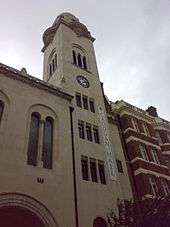Cadogan Hall

Cadogan Hall /kəˈdʌɡən/ is a 950-seat capacity[1] concert hall in Sloane Terrace in Chelsea / Belgravia in the Royal Borough of Kensington and Chelsea, London, England.
The resident music ensemble at Cadogan Hall is the Royal Philharmonic Orchestra (RPO), the first London orchestra to have a permanent home. Cadogan Estates offered the RPO the use of the hall as its principal venue in late 2001.[2] The RPO gave its first concert as the resident ensemble of Cadogan Hall in November 2004.[3] Since 2005, Cadogan Hall has also served as the venue for The Proms' chamber music concerts during Monday lunchtimes[4][5] and Proms Saturday matinees; it is also one of the two main London venues of the Orpheus Sinfonia.[6]

Cadogan Hall has also been used as a recording venue. In February 2006, a recording of Mozart symphonies with John Eliot Gardiner and the English Baroque Soloists was produced and made available immediately after the performances occurred.[7][8] In 2009, art rock band Marillion recorded a concert there which was released on the album Live from Cadogan in 2011.
Building
Grade II listed,[9] the building is a former Church of Christ, Scientist church (First Church of Christ, Scientist, London), completed in 1907 to designs in the Byzantine Revival style by architect Robert Fellowes Chisholm, who also designed the Napier Museum in Kerala, India.[10] By 1996, the congregation had diminished dramatically and the building fell into disuse. Mohamed Fayed, the then owner of Harrods, had acquired the property, but was unable to secure permission to convert the building to a palatial luxury house on account of its status as a listed building. Cadogan Estates Ltd (the property company owned by Earl Cadogan, whose ancestors have been the main landowners in Chelsea since the 18th century – the nearby Cadogan Square and Cadogan Place are also named after them) purchased the building in 2000.[2] It was refurbished in 2004 by Paul Davis and Partners architects at a cost of £7.5 million.[11] The changes included new lighting and sound systems and bespoke acoustic ceiling modules in the performance space.[12][13]
References
- ↑ "Seating plan". Cadogan Hall. Retrieved 3 April 2013.
- 1 2 Louise Jury (8 January 2002). "London Philharmonic gets a concert centre". The Independent. Retrieved 9 August 2008.
- ↑ Annette Moreau (5 November 2004). "Royal Philharmonic Orchestra/Bliss, Cadogan Hall, London". The Independent. Retrieved 9 August 2008.
- ↑ "Proms Chamber Music at Cadogan Hall" (PDF) (Press release). BBC Proms. 27 April 2005. Retrieved 9 August 2008.
- ↑ Jessica Duchen (18 July 2008). "BBC Proms: Everything you wanted to know (but were afraid to ask)". The Independent. Retrieved 9 August 2008.
- ↑ "Orpheus Sinfonia". Orpheus Foundation. Retrieved 27 July 2013.
- ↑ Charlotte Higgins (7 February 2006). "Look sharp: chance to buy live CD straight after the concert". The Guardian. Retrieved 18 September 2010.
- ↑ Andrew Clements (17 February 2006). "Mozart: Symphonies No 39 and 41, English Baroque Soloists/ Gardiner". The Guardian. Retrieved 18 September 2010.
- ↑ Historic England. "Grade II (424005)". Images of England.
- ↑ "Napier Museum". The Hindu: Metro Plus Thiruvananthapuram. 12 December 2009. Retrieved 28 July 2013.
- ↑ "Cadogan Hall". Paul Davis and Partners Architects. Retrieved 20 August 2012.
- ↑ "Cadogan Hall". Black sea audio. Retrieved 19 February 2014.
- ↑ "Our History". Cadogan Hall. Retrieved 27 September 2013.
External links
- Official website
- Cadogan Estates Ltd
- The Proms' page on Cadogan Hall
- Tim Ashley, "Let's not forget about the Cadogan Hall Proms". The Guardian Music Blog, 19 July 2007
-
 Media related to Cadogan Hall at Wikimedia Commons
Media related to Cadogan Hall at Wikimedia Commons
See also
Coordinates: 51°29′37″N 0°09′27″W / 51.4936°N 0.1576°W